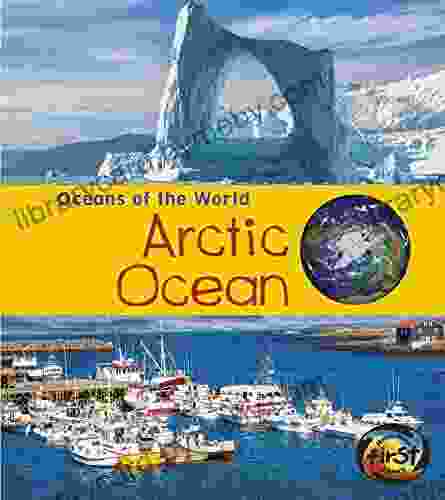The Arctic Ocean, the smallest and northernmost of the world's oceans, conceals a captivating realm of unparalleled beauty and scientific significance. Its vast expanse, frozen waters, and unique biodiversity have drawn explorers, scientists, and adventurers for centuries. In "Arctic Ocean: Oceans of the World," a comprehensive and enchanting book, we delve into the depths of this frigid wilderness, unveiling its mysteries and showcasing its extraordinary wonders.
Physical Geography
The Arctic Ocean covers an area of approximately 14.06 million square kilometers, encircling the Arctic Circle. Surrounded by North America, Europe, and Asia, it is connected to the Pacific Ocean by the Bering Strait and to the Atlantic Ocean by the Greenland Sea and Baffin Bay. Its average depth is around 1,200 meters, reaching a maximum depth of over 5,000 meters in the Amerasian Basin.
5 out of 5
| Language | : | English |
| File size | : | 11694 KB |
| Screen Reader | : | Supported |
| Print length | : | 32 pages |
The most striking feature of the Arctic Ocean is its sea ice, which fluctuates in coverage throughout the year. During winter, the ocean becomes an almost solid expanse, with ice thickness reaching up to 3 meters or more. In contrast, during summer, the ice melts significantly, creating navigable channels and open water.
Climate
The Arctic Ocean's climate is characterized by extreme temperatures and a lack of precipitation. Temperatures hover around freezing point throughout the year, with winter temperatures plunging to below -40 degrees Celsius. In summer, the mercury may rise slightly above 0 degrees Celsius, but it remains chilly for most of the season.
The Arctic Ocean receives minimal precipitation, averaging around 15 centimeters per year. This is due to the cold, dry air that dominates the region. The lack of rain and snowfall contributes to the formation of sea ice and the maintenance of a harsh, unforgiving environment.
Biodiversity
Despite its frigid waters, the Arctic Ocean supports a diverse range of marine life. Polar bears, walruses, seals, and whales are among the most iconic species found in this ecosystem. The ocean's depths also harbor a variety of fish, crustaceans, and seabirds.
Polar bears depend heavily on sea ice for hunting and breeding. Walruses use ice floes for hauling out, nursing, and resting. Seals, such as bearded seals and ringed seals, are well-adapted to the Arctic environment with their thick blubber and ability to dive deep for food.
Whales, including bowhead whales, gray whales, and belugas, migrate to the Arctic Ocean to feed and calve. The ocean's abundant krill populations provide a vital food source for these massive marine mammals.
Exploration and Scientific Research
The Arctic Ocean has long attracted explorers seeking to uncover its secrets and navigate its treacherous waters. In the 19th and 20th centuries, expeditions led by Fridtjof Nansen, Roald Amundsen, and Robert Peary pushed the boundaries of human knowledge and endurance in the Arctic.
Today, scientific research in the Arctic Ocean focuses on understanding its role in global climate change, its unique ecosystem, and its potential natural resources. Scientists study the ice cover, ocean currents, and marine life to gain insights into the health and stability of this vital ecosystem.
Environmental Challenges
The Arctic Ocean is facing significant environmental challenges due to human activities and climate change. Melting sea ice, ocean acidification, and pollution are among the most pressing threats to its delicate ecosystem.
The loss of sea ice is a major concern as it disrupts polar bear and other ice-dependent species. Ocean acidification weakens the shells of marine organisms, making them more susceptible to predators and disease. Pollution from industrial and agricultural sources is accumulating in the Arctic Ocean, posing risks to marine life and the overall health of the ecosystem.
Economic Importance
While the Arctic Ocean is a vast and remote region, it has significant economic importance. Potential oil and gas reserves, as well as valuable fisheries, attract commercial interests to the area. The Northwest Passage, a potential shipping route that connects the Pacific and Atlantic oceans through the Arctic, is also gaining attention as sea ice melts and opens up new opportunities for navigation.
The Arctic Ocean, a captivating and enigmatic realm of icy waters and vibrant life, remains one of the last great frontiers on Earth. Through "Arctic Ocean: Oceans of the World," we have explored the physical geography, climate, biodiversity, exploration history, environmental challenges, and economic importance of this extraordinary ocean.
Understanding the Arctic Ocean's role in global systems and the threats it faces is crucial for safeguarding its future and ensuring the well-being of our planet. As we continue to gather knowledge and search for solutions, we can work towards preserving the Arctic Ocean's pristine beauty and protecting its fragile ecosystem for generations to come.


























































































